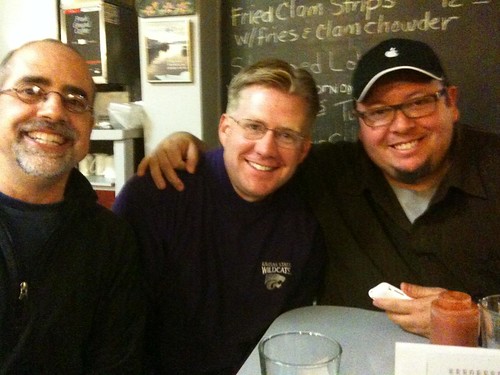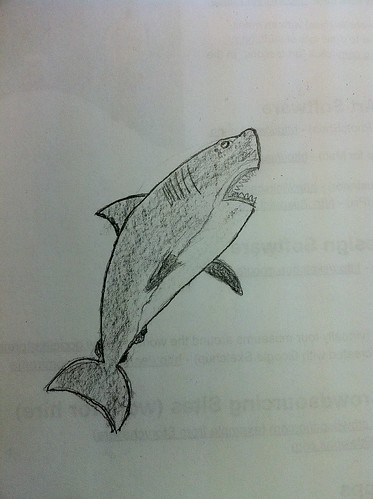Today was my fourth week teaching a 50 minute “Life Skills” lesson at the “Tiger Club” after school program hosted by our church in Edmond, Oklahoma. This is a free after-school program provided for students attending Central Middle School in Edmond Public Schools. In this post, I’m going to describe the lesson “Be a Digital Artist” which I taught today to students primarily using resources provided by Kevin Honeycutt and ESSDACK on their fantastic, free website “Art Snacks.” All the referenced links from this lesson are available on wfryer.me/ca. I’ve embedded the Google Document below which we provided as print handout to students. Please borrow/copy/use any of these ideas with your students and kids.
The past three weeks I’ve facilitated lessons with about twelve different 6th, 7th and 8th grade students about storytelling and puppet movies. The first two weeks we used Puppet Pals on the iPad, and last week we used real finger puppets to make some short skit videos. We published some of our work from both weeks to the multimediasandbox YouTube channel. This has been a worthwhile but challenging series of lessons. See my January 19th post, “Lessons Learned Using Puppet Pals on iPads in an After School Program,” for more background. We haven’t created any masterpieces, but we have had fun discussing the story arc and making short videos which (generally) attempt to present a coherent message. 50 minutes isn’t a lot of time to have to create and share stories, but we’ve done the best we could with the time and resources available.
One of the primary things I’ve wrestled with as I’ve considered what to teach these students in “Life Skills” lessons involving the iPad is this: None of these students own iPads or have access to iPads at home. What kinds of things should I teach them which can have immediate relevance in their lives, as well as potential long term relevance? Sure we’ve had fun making some short videos with digital and actual puppets, but these activities aren’t things they can repeat on their own when I leave with the three iPads I’ve brought to class each day. I have had the privilege of being with Kevin Honeycutt in the past when he taught incarcerated, Kansas youth short lessons (on behalf of ESSDACK) and used art as a way to both “reach” them and have important discussions about life as well as learning. I’m no Kevin Honeycutt, I have very limited drawing skills, and the kids I’m teaching in “Tiger Club” definitely aren’t incarcerated youth… but a talk with him on the phone earlier this week motivated me to share a lesson with my students on the possibilities for becoming a digital artist.
I started the lesson today asking who liked to draw, who considered themselves artists, and who thought they were creative. I explained we ALL are artists and have creative skills, but not all of us think about ourselves that way. I asked about how long people have been creating drawings and telling stories, and we discussed how that goes back to “the cave.” As humans, some of us have always been driven to draw and share stories through art. It’s in our DNA.
I shared a story with the students about our Storychasers logo, which we outsourced via crowdSPRING. 99Designs is a similar web community for graphic artists and folks needing design work.
I explained how our Storychasers group received 147 design concepts (low resolution digital art drawings) of logo ideas from 43 different designers from around the world.
Eventually, we selected one we liked which turned out to be the work of a graphic designer in eastern Europe who lives in Zagreb, Croatia. One of the designers we initially considered was coincidentally based in Oklahoma, but we had problems with them providing higher resolution versions of the logo draft they’d made. It’s pretty amazing we paid someone $500 to make a logo for us who we never met and lives all the way across the Atlantic Ocean in another country! This is a real story of outsourcing and digital creativity, and I wanted to share it so my students would at least be exposed to the idea that digital artists can now access a world of work possibilities via the Internet. It doesn’t matter where you live: Creative skills are needed and marketable.
I showed students on our printed as well as digital handout where they could access links to FREE digital art programs like the Gimp, that have similar features as Adobe PhotoShop that costs $700 to buy. Hopefully some of them will check it out and pursue some digital art creative possibilities on their own following our “Life Skills” class series.
I next introduced my students to the iPad app Brushes, and showed them several recent creations by my 8 year old daughter, Rachel.
I showed students how the iPad Brushes app lets us “replay” a video of how Rachel made these drawings, and I showed them some other amazing YouTube examples of iPad drawings using Brushes as well. We watched these and discussed the techniques the artists used.
At this point I need to give a hat tip to Marco Torres, who was the first person to share the Brushes app with me several years ago in Maine. Although I haven’t become an acknowledged digital artist with Brushes since I learned about it, I have both played with it and shared it with many people. This is a specific example of how the opportunity to meet and hang out with creative people (which Apple specifically facilitated in my life via various means) has been life changing. “But for” my very brief chances to hang with Marco and learn from him, I probably wouldn’t have been teaching my students about Brushes on the iPad today. “But for” my opportunities to hang out with Bob Sprankle, I would know far less about podcasting, webcasting, and iPhoneography. I tried to communicate this idea to my students today: If we want to learn how to do something, we need to hang out with other people who know how to do it well. That’s how a lot of learning happens. It’s a big reason we need to choose our friends carefully.
In addition to viewing these examples of digital art with Brushes today, I also showed students this video of art created with Autodesk SketchBook Pro for iPad.
Before handing out the iPads to students, I demonstrated the basics of drawing with Brushes using an AppleTV which mirrored my iPad2 screen. Next, I introduced students to the free “Art Snacks” online community facilitated by Kevin Honeycutt and explained they would be drawing a Great White Shark today. We had paper and pencils available, and students took turns drawing on the available iPads (3) as well as my iPhone which had the Brushes app loaded. I had one stylus which students used, but unfortunately broke (the tip came off) during the lesson. Together we watched Kevin’s “Artsnacks Great White Shark” video on YouTube. I paused it several times for students to compare drawings and add to their drawings. As Kevin had suggested to me, some of the kids were really into it and were loving the chance to learn some new art techniques. Others were less engaged, but since everyone could at least draw with paper and pencil this was a lesson that was “doable” by everyone.
Here are some examples of drawings we made in class. The last one is my own. It is risky and takes some courage to share your own art with others, especially when (like me) you’re not very confident in your own art skills. I think this is a good way to model both creativity and instructional risk taking with students, however. We learn the most when we are “stretched” out of our personal comfort zones, and these are times when we try new things that we’re not entirely comfortable doing.
This lesson provided some good opportunities to talk about “important stuff” with students in addition to digital art and drawing skills. When I asked the students what they thought of my drawing partway through Kevin’s video, one of them said, “That looks horrible!” We talked about how those words might make me feel, even though the student quickly said, “I was just kidding.” We talked about bullying, and how important and powerful the words we choose are. I talked about how there are far TOO MANY people in this world who “use their words” to hurt and inflict pain on others. I told the students I sometimes mess this up, but I try to use my words as much as I can to build others up and give them POWER instead of tearing them down.
I don’t know what lessons from today’s “digital art discussions” my students will remember, but we never do when we teach… do we? I felt better about today’s “Life Skills” lesson than I have all year, and I know a big reason the lesson was a success was I used resources provided by Kevin Honeycutt and Art Snacks. If you haven’t shown Art Snacks to your own students, DO IT soon. Not all the kids in any classroom love art and will want to learn more about making art, but chances are high SOME WILL.
Teach your students how to be digital artists, even if (like me) you don’t consider yourself to have very developed drawing skills. We are all creative, and we can all be artists. To be an artist, we have to CREATE things. We need to MAKE stuff. Today, we have lots of opportunities to play with media and not only share digital art, but also sell it on sites like crowdSPRING and 99designs. Share these possibilities with your students too. Making and sharing art certainly has intrinsic value and isn’t all about monetization. Some kids may not have considered these possibilities, however. Your students could not only be outsourced digital designers for someone else, down the road they might also use digital outsourcing for their own projects like we did with Storychasers last year.
Who knows where that shared knowledge may take them and us? The possibilities are exciting.
Hat tip to Cody Birsner for sharing 99designs with me a few months ago.
Technorati Tags: creativity, edmond, ipad, oklahoma, art, brushes, create, kevin, honeycutt, artsnacks, essdack, fpce, tiger, club
If you enjoyed this post and found it useful, subscribe to Wes’ free newsletter. Check out Wes’ video tutorial library, “Playing with Media.” Information about more ways to learn with Dr. Wesley Fryer are available on wesfryer.com/after.
On this day..
- The Council of Constance and Modern Web – 2021
- American Revolution Videos from Schoolhouse Rock and Discovery United Streaming – 2014
- Hacker Cases Highlight Need for Greater Personal Account and Information Security – 2014
- Cross Examination Debate Flow Template for Numbers in iWork ’09 – 2012
- Blog comment moderation: How and Why? – 2010
- Crescent Public Schools: The Eyes of Oklahoma Are Upon You! – 2010
- Present at OSSBA in August 2010 – 2010
- eDiscovery requirements and archiving student email – 2010
- iPhone iTalk Application: A Great Event Recorder – 2009
- Comparing Broadband USB Options for Laptops – 2009












Comments
3 responses to “Teach Your Students to be Digital Artists (and learn from Kevin Honeycutt)”
Computers and tablets are only assistants and a good
teacher’s will always be needed.
However social networks such as facebook and YouTube as well
as great resources including Wikipedia and Wolfram-Alpha are here to stay so
that educators must use them in the teaching process.
Some time ago YouTube moved a lot of their educational
content to a separate domain giving people access a broad set of educational
videos.
However, some complaints include the variety of the content
found there as well as the need for schools to register on YouTube under the
academic section in order to show their videos, leaving out many academics,
professionals and students not formally associated with mainstream schools
which contribute with great videos.
Many academics are posting great educational videos and
materials online. The only problem is to sort the good ones from the rest and
present them in an organized manner.
This effort is being done by: http://utubersity.com
which presents the best educational videos available on YouTube in an
organized, easy to find way to watch and learn. It also links the videos to
related content in Wikipedia or associated websites.
They are classified and tagged in a way that enables people
to find these materials more easily and efficiently and not waste time browsing
through pages of irrelevant search results.
The website also enhances the experience using other means
such as recommending related videos, Wikipedia content and so on. There’s also
a Spanish version called http://utubersidad.com
This is a fabulous post that I want to go through carefully. I’m a middle school literacy teacher who designed a creativity website with hope of inspiring my students as they grow into adulthood. They will enjoy the links you shared.
This post really resonated with me, Wes. I cannot draw to save my life, but I LOVE the fact that apps make some kind of “art” accessible to people like me. I tend to go on at length about creativity on my blog, The Book Chook, where I have had people comment that the “best” creating is with real pen, pencil or paint. And maybe they’re right. Yet, I know there will be kids who will take off with joy to find a way to express themselves via an iPad app or an image editor or comic software. To me, that’s exciting!